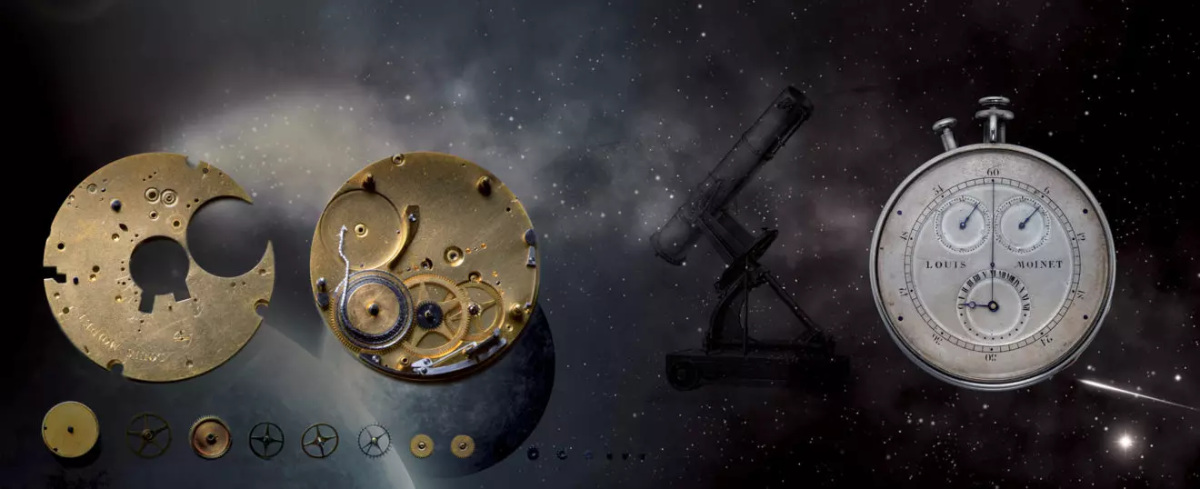Louis Moinet Wins A New Guinness World Records™ Title For The First High-frequency Stopwatch
Luxferity, 09.04.2021
"I am delighted to announce that Louis Moinet wins a new Guinness World Records™ title for the first high-frequency stopwatch!
I encountered Louis Moinet more than 20 years ago. I am very happy that his work has been rewarded today. Obtaining two Guinness World Records™ titles is an exceptional accomplishment! His Compteur de Tierces reflects the genius of a man ahead of his time, who not only invented the chronograph but also high frequency. This "first high-frequency stopwatch" award for his Compteur de Tierces made in 1816 definitively places Louis Moinet in the circle of the world’s most avant-garde watchmakers," Jean-Marie Schaller, CEO & Creative Director of Louis Moinet.
FIRST CHRONOGRAPH AND HIGH-FREQUENCY STOPWATCH*
In one of his handwritten letters (1), Louis Moinet tells the story: "After various stays in Paris where I spent time with Breguet the elder, I went there for the last time in 1815 to have a compteur de tierces or 60ths of a second made, which I wanted to use for an astronomical instrument that I had built some time before and that Mr Fortin had made for me.” In another note (1), the inventor specifies that this compteur "was not completed until 1816". Designed to measure tierces (a French term referring to a third subdivision of hours after the minutes and seconds), for the first time in the history of watchmaking, this instrument was equipped with an escapement beating at 216,000 vibrations per hour (vph). Although there was a similar attempt by the English watchmaker John Arnold the elder, which did not lead to any significant development, the height of this frequency was truly prodigious at the time of its creation.
The origins of precision
The horological history of frequencies began in 1675 when Christian Huygens invented a regulating balance-spring paired with a circular balance featuring constant periodic motion. Also known as a hairspring, this coiled steel wire provides the torque required to make the balance oscillate and to regulate its frequency, i.e. the number of oscillations, an oscillation equivalent to two vibrations, performed within a unit of time, such as an hour or a second.
In 1754, Jean Romilly presented the first so-called deadbeat seconds watch to the Académie royale des Sciences in Paris. Twenty-two years later, Jean-Moïse Pouzait submitted an independent deadbeat seconds watch to the Société des Arts in Geneva with a balance oscillating at 7,200 vph (1 Hertz). Its double mechanism made it possible to halt the seconds hand without stopping the main movement. At the end of the 18th century, various models were introduced with escapements beating at 14,400, 18,000 and 21,600 vph respectively, with a small jumping hand called a foudroyante or diablotine to indicate quarters, fifths or – in the 19th century – sixths of a second. Given that background, how can one explain this prodigious and instantaneous leap to Moinet's 216,000 vph (30 Hz) in 1816, at a time when soldiers adjusting cannon fire and bettors assessing the performance of racehorses were generally satisfied with 18,000 vph (2.5 Hz)?
From 18,000 to 216,000 vph in one giant step
The answer to this question lies in astronomers’ new expectations sparked by the 17th century appearance of the ancestor of the telescope that would establish itself two centuries later.The meridian telescope was specially designed to measure the heights of the stars above the horizon at the exact moment of their passage through the meridian plane by virtue of diurnal motion. Knowing these two items of data enabled the elaboration of sky charts, star catalogues and ephemerides, the accuracy of which depends on that of the time measuring instrument used. At the time, the tierce, an astronomical calculation unit simultaneously dividing the second and the degree of angle, was THE benchmark because it served to measure both time and space.
In spite of the prodigious progress made by the compteur de tierces, it did not become widely known in scientific circles. Moinet had had it made for his own use and for some unknown reason its invention was not published. The proposal to make it "available to anyone who would like to have it built in large numbers", was not taken up (3).

Striking a balance between scientists’ requirements and R&D
In 1816, Louis Moinet had a lead of some five or six years on Nicolas-Matthieu Rieussec. The latter proved capable of timing – in fifths of a second and using an apparatus he had invented – a horse race organised on September 1st 1821 on the Champ de Mars in Paris (4). Even more remarkably, the compteur de tierces preceded Heuer's Mikrograph by 100 years.
In watchmaking, an increase in frequency improves precision, with the corollary of certain hard to resolve technical problems, including increased energy consumption, inertia of the wheels and pinions, as well as impact on lubrication.
Twentieth of a second measurement was achieved in 1896 with the Nicole, Nielsen & Co stopwatch, featuring a balance oscillating at 72,000 vph (10 Hz).
In 1916, one hundred years after Moinet's compteur de tierces, Heuer patented two pocket stopwatches: the Semikrograph indicating fiftieths of a second, 180,000 vph (25 Hz), and the Mikrograph indicating hundredths of a second, 360,000 vph (50 Hz). The latter would be produced for 60 years. In 2011, TAG Heuer presented its Mikrograph 1/100, the first self-winding wrist chronograph capable of measuring and displaying one hundredths of a second with a jumping seconds hand that makes one full turn around the dial in one second. It incorporates two escapements: one beating at 28,800 vph (4 Hz) and reserved for the time functions, the other at 360,000 vph (50 Hz) for the chronograph. In the same year, the Manufacture further explored the field of high frequencies. Its Microtimer Concept Chronograph was the first in the world to mechanically measure one thousandths of a second (3,600,000 vph, 500 Hz). In 2012, TAG Heuer presented its Mikrogirder, displaying two-thousandths of a second. Its escapement beats at 7,200,000 vph (1,000 Hz) and is 250 times faster than that of a conventional watch. Its central seconds hand then makes 20 turns of the dial per second, a speed making it impossible to follow with the naked eye.
In each successive era, watchmakers have pushed back the limits of the rules of physics and mechanics, transcending the realms of apparent feasibility in order to overturn burdensome habits and preconceptions. When it comes to the field of high-frequency watchmaking, it is unquestionably Louis Moinet who first blazed this particular trail.
SOURCES
(1) Private collection
(2) Nouveau Traité Général d'Horlogerie, Louis Moinet, 1848 edition, volume 1, p. 47.
(3) Nouveau Traité Général d'Horlogerie, Louis Moinet, 1848 edition, volume 2, article 1531.
(4) The Mastery of Time, Dominique Fléchon, Editions Flammarion, 2011, p. 257.
*Text written by Dominique FLECHON, historian and expert in fine watchmaking.












